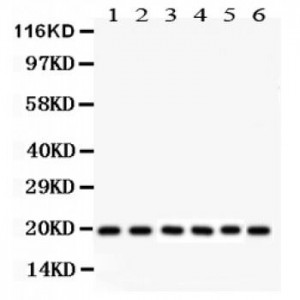More info
Overview
Long Name | Antibody Type | Antibody Isotype | Host | Species Reactivity | Validated Applications | Purification |
| peptidylprolyl cis/trans isomerase, NIMA-interacting 1 | Polyclonal | IgG | Rabbit | Human, Mouse, Rat | WB | Immunogen affinity purified. |
Immunogen | ||||||
| E.coli-derived human Pin1 recombinant protein (Position: M1-E163). Human Pin1 shares 95% amino acid (aa) sequence identity with mouse Pin1. | ||||||
Properties
Form | Lyophilized |
Size | 100 µg/vial |
Contents | Antibody is lyophilized with 5 mg BSA, 0.9 mg NaCl, 0.2 mg Na2HPO4, 0.05 mg NaN3. *carrier free antibody available upon request. |
Concentration | Reconstitute with 0.2 mL sterile dH2O (500 µg/ml final concentration). |
Storage | At -20 °C for 12 months, as supplied. Store reconstituted antibody at 2-8 °C for one month. For long-term storage, aliquot and store at -20 °C. Avoid repeated freezing and thawing. |
Additional Information Regarding the Antigen
Gene | PIN1 |
Protein | Peptidyl-prolyl cis-trans isomerase NIMA-interacting 1 |
Uniprot ID | Q13526 |
Function | Peptidyl-prolyl cis/trans isomerase (PPIase) that binds to and isomerizes specific phosphorylated Ser/Thr-Pro (pSer/Thr- Pro) motifs in a subset of proteins, resulting in conformational changes in the proteins (PubMed:21497122, PubMed:22033920). Displays a preference for an acidic residue N-terminal to the isomerized proline bond. Regulates mitosis presumably by interacting with NIMA and attenuating its mitosis-promoting activity. Down-regulates kinase activity of BTK (PubMed:16644721). Can transactivate multiple oncogenes and induce centrosome amplification, chromosome instability and cell transformation. Required for the efficient dephosphorylation and recycling of RAF1 after mitogen activation (PubMed:15664191). Binds and targets PML and BCL6 for degradation in a phosphorylation-dependent manner (PubMed:17828269). Acts as a regulator of JNK cascade by binding to phosphorylated FBXW7, disrupting FBXW7 dimerization and promoting FBXW7 autoubiquitination and degradation: degradation of FBXW7 leads to subsequent stabilization of JUN (PubMed:22608923). |
Tissue Specificity | The phosphorylated form at Ser-71 is expressed in normal breast tissue cells but not in breast cancer cells. |
Sub-cellular localization | Nucleus. |
Sequence Similarities | Contains 1 PpiC domain. |
Aliases | DOD antibody|DODO, Drosophila, homolog of antibody|FLJ40239 antibody|FLJ77628 antibody|MGC10717 antibody|NIMA interacting 1 antibody|Peptidyl prolyl cis trans isomerase NIMA interacting 1 antibody|Peptidyl prolyl cis/trans isomerase NIMA interacting antibody|Peptidyl-prolyl cis-trans isomerase NIMA-interacting 1 antibody|Peptidyl-prolyl cis-trans isomerase pin1 antibody|Peptidylprolyl cis/trans isomerase NIMA interacting 1 antibody|Pin 1 antibody|Pin1 antibody|PIN1_HUMAN antibody|PPIase Pin1 antibody|Prolyl isomerase antibody|Protein (peptidylprolyl cis/trans isomerase) NIMA interacting 1 antibody|Protein NIMA interacting 1 antibody|Rotamase Pin1 antibody|UBL 5 antibody|UBL5 antibody |
Application Details
| Application | Concentration* | Species | Validated Using** |
| Western blot | 0.1-0.5μg/ml | Human, Mouse, Rat | AssaySolutio's ECL kit |
AssaySolution recommends Rabbit Chemiluminescent WB Detection Kit (AKIT001B) for Western blot. *Blocking peptide can be purchased at $65. Contact us for more information

Anti- PIN1 antibody, ASA-B1524, Western blotting
All lanes: Anti PIN1 (ASA-B1524) at 0.5ug/ml
Lane 1: Rat Lung Tissue Lysate at 50ug
Lane 2: Mouse Lung Tissue Lysate at 50ug
Lane 3: NRK Whole Cell Lysate at 40ug
Lane 4: A549 Whole Cell Lysate at 40ug
Lane 5: 293T Whole Cell Lysate at 40ug
Lane 6: MCF-7 Whole Cell Lysate at 40ug
Predicted bind size: 19KD
Observed bind size: 19KD
All lanes: Anti PIN1 (ASA-B1524) at 0.5ug/ml
Lane 1: Rat Lung Tissue Lysate at 50ug
Lane 2: Mouse Lung Tissue Lysate at 50ug
Lane 3: NRK Whole Cell Lysate at 40ug
Lane 4: A549 Whole Cell Lysate at 40ug
Lane 5: 293T Whole Cell Lysate at 40ug
Lane 6: MCF-7 Whole Cell Lysate at 40ug
Predicted bind size: 19KD
Observed bind size: 19KD



